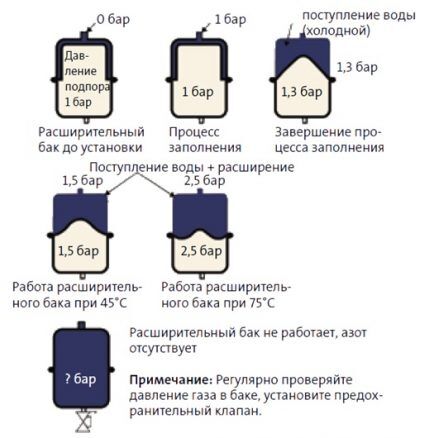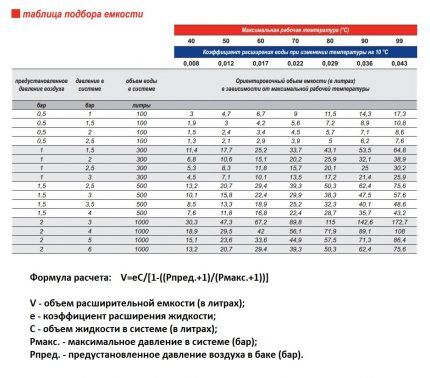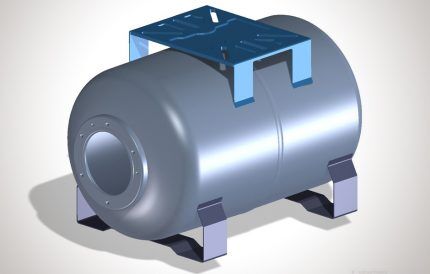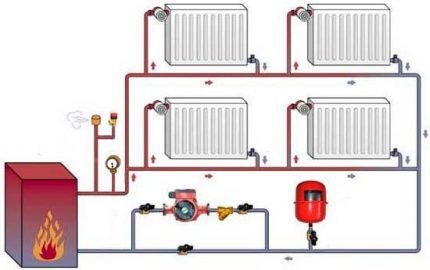Expansion tank for closed type heating: principle of operation and device + how to select and install in the system
A properly selected and connected expansion tank for closed-type heating plays an important role.It will protect the heating circuit and extend the operating life of the equipment. A closed, sealed container will eliminate the need to endlessly repair the system and change devices. It's worth getting to know her. Is it true?
We will tell you how to choose a closed expansion tank model in accordance with the technical data of the system. We'll show you how to install and connect it correctly. In addition, the article provides recommendations that must be followed to extend the life of the equipment.
The content of the article:
Purpose of closed tanks
All of them, regardless of volume, productivity, are designed to level out expansion coolant (special liquids, water), which occurs when its temperature increases.
This is done in order to avoid destructive water hammer, damage to fittings, fittings, pipe rupture heating systems, squeezing out gaskets.

Example: the coolant (water) expands by four percent as the temperature rises to 95 °C. Which is quite enough for the engineering system to fail.
Expanzomat design and components
Any such modern product consists of the following structural elements:
- housings;
- coolant chambers;
- a gas chamber into which ordinary air or inert gas is pumped;
- membranes.
The option of filling the gas chamber with inert gas is more preferable, because it provides the container with greater durability. But regular air is more accessible.
The membrane is made of elastic materials, therefore it is able to change its position as the temperature of the coolant increases or decreases. This structural element can be of the diaphragm or balloon type, and their operating principle is similar.
The tanks are connected to the heating system using a special pipe. A valve is provided for pumping gas. Closed-type containers are manufactured in a horizontal or vertical layout, which makes it easier to complete the heating system.

Containers intended for installation in closed heating systems, are equipped with pressure gauges to monitor internal pressure. Similar products intended for installation in systems of ordinary private houses operate at low loads not exceeding 3.5-4 bar, so they do not require measuring instruments.
You can also find two types of tanks on sale:
- with a non-replaceable or stationary diaphragm-type membrane, that is, a break, the wear of which will lead to the replacement of the entire device;
- with a replaceable balloon-type membrane.
In the first case, the products are distinguished by a more affordable price, in the second by greater functionality, maintainability and durability.
The design of flanged tanks allows you to replace a worn or damaged membrane, and in some cases you can even do this yourself.And replaceable membranes can withstand greater pressure.
Expansion tank operation diagram
When the coolant is cold, the tank membrane occupies as much space as possible. As the temperature rises, the pressure on it increases.
As a result, the specified structural element overcomes the resistance of the inert gas or air and changes its position, freeing up more space for the resulting excess liquid.

When the coolant cools down, the opposite process occurs to that described above. And then the cycles are repeated many times.
Recommendations for choosing a container
The most important feature that you should pay attention to when choosing a model expansion tank, is the volume of its reservoir. For closed systems with a small circuit, the volume of coolant in which does not exceed 150 liters, the capacity is easy to calculate.
So, it should be:
- when using water as a coolant - 10% of the volume of the entire heating system (for example, if this figure is 100 liters, then the expansion tank must hold at least 10 liters);
- when using glycol liquid as a coolant - 15% of the volume of the heating system.
In the latter case, the capacity should be larger due to the greater expansion coefficient of the specified antifreeze.

The volume of the tank for larger systems, the circuit of which circulates more than 150 liters, is most conveniently calculated using the parameter of the total volume of the system and a table for selecting a tank.
To calculate the total volume of the system, you can use the following methods:
- Measure the volume of coolant circulating in all individual elements of the system (boiler, radiators, pipelines) and then sum up the results obtained. This method is highly labor intensive, but at the same time it is the most accurate.
- Multiply each kilowatt of boiler power by 15, assuming that on average there are about 15 liters of coolant per 1 kW. This method is simple, but you should remember that you can trust the result only when you are confident in the correct selection of the heating element for the system.
- Drain all water from the system and refill it, calculating the required displacement.
You can also use formulas or an online calculator to calculate the required tank volume. Why is it necessary to know the volume of coolant, its temperature and pressure in the system.
The method with formulas is more complex and the volume obtained as a result of calculations will not differ significantly from the rough calculation given above. Moreover, the found value must be rounded up.

The most practical solution when choosing will be an expansion tank designed for closed-type heating systems, equipped with safety valve.
The reason is that when the pressure rises to critical standards, the device will start working and bleed it. That is, this valve can significantly increase the safety of the entire heating system.
When purchasing a container, you should take into account that red paint is most often used to mark expansion tanks used for heating.
This feature will help to distinguish the desired product from other similar ones, for example, water supply tanks of similar size and shape - hydraulic accumulators, which are predominantly covered with blue enamel.
But if necessary, you can find tanks of various colors, which will help you place the one you need in any room without compromising its aesthetic qualities.

When choosing, you should also pay attention to the quality of the materials used in the production of the container body and membrane. And the presence of a guarantee for the purchased equipment and instructions for installing and connecting it to the system.
How to install?
Any significant restrictions affecting the location expansion tank installation in the system, no. Nevertheless, it is advisable to carry out the installation at any convenient point in the return line of the existing heating system.
The reason is that the coolant there is cooler. And this allows you to significantly extend the life of the expansion tank and its membrane.
In addition, if you install the tank near a solid fuel boiler, then in certain situations steam may enter the coolant chamber. As a result, the container will lose the ability to compensate for the expansion of the coolant.
Installation of the tank can be done in two ways. These include installation:
- on the wall;
- on the floor.
But it should be understood that the first option is intended only for cases where the expansion tank has a moderate volume.

You should not skimp on connecting the tank to the heating system.
So this procedure should be performed using:
- a shut-off valve with a so-called “American” - this design element will allow you to quickly remove the tank from service and, if necessary, replace it, without waiting for the coolant to cool down;
- a tee with a drain tap, which will allow you to quickly empty it before replacing the tank;
- pressure gauge for measuring pressure;
- safety valve or nipple to regulate the pressure inside the equipment.
After installing the tank, it must be configured correctly, taking into account the manufacturer’s recommendations given in the instructions for the purchased equipment. So that the pressure in the tank is appropriate, i.e. less than in the system, which will allow the membrane to deform when the coolant heats up.
If the calculations were carried out incorrectly and the heating system contains a tank of a smaller volume than required, then it will not cope with its duties, but the error can be corrected.
Why do you need to purchase and install a second container in the system? The capacity of which is the difference between the required volume and that available in the tank operating in the system. This method will reduce financial losses.
Operational Maintenance
It must be remembered that during breaks in use, the tanks, like other components of the heating system, should be emptied and then dried. This point should not be ignored, as failure to comply will lead to corrosion and reduced service life.

When using any closed tank, owners should regularly perform a number of simple operations.
Which include:
- periodic inspections to detect corrosion and mechanical damage - this procedure should be carried out twice a year;
- checking the pressure in the system, which is performed every six months;
- periodic inspections of the integrity of the membrane - such operations are carried out according to the manufacturer’s recommendations.
And in addition, throughout the entire operation, users will have to comply with the requirements regarding permissible temperature and pressure standards.
To repair tanks, you should use only original components, as this will ensure not only the required performance, but also safety of use.
Will familiarize you with the rules and features of selecting an expansion tank for open-type heating systems next article, This is worth reading for owners of houses with open heating circuits.
Conclusions and useful video on the topic
The first video will help you understand the features of modern expansion tanks and their correct choice:
The following video will give you an opportunity to understand how to properly install a purchased expansion tank:
The closed cistern is a practical, durable, efficient and safe solution for the heating system. But in order to get the expected result, it is necessary to make the correct selection and installation of the product in the heating system and its configuration.
Please write comments in the block below, share useful information and photos on the topic of the article. Tell us about how you selected a closed tank for the heating system in a country house. Discover your technological secrets that will be useful to site visitors.



